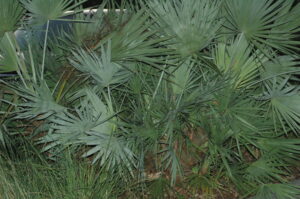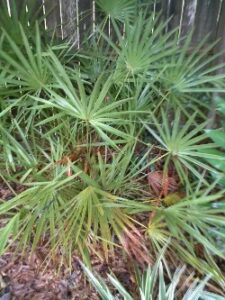Saw Palmetto Palm
( Serenoa Repens )
Saw Palmetto Palm Origins:
– Serenoa Repens / Saw Palmetto is native to Florida and much of the lower
southeastern United States.
– Perfect for understory plantings in the North Florida | Jacksonville |
St. Augustine area landscapes.
– Underused plant selection is almost maintenance free!
– The leaves and fruits of the saw palmetto are food to over 200 species of
wildlife including mammals and birds and are an integral part of our local ecosystem.
– Fruits (drupes) of the saw palmetto have long been used medicinally for
treatment of various ailments.
Saw Palmetto Palm Preferred Exposure:
– Saw Palmetto Palm can be planted in a partial sun / partial shade
location or in complete shade in the North Florida / Jacksonville / St. Augustine area landscape.
Saw Palmetto Palm Fronds | Trunk:
– Foliage of the Saw Palmetto Palm remains evergreen through severe frosts and is extremely cold hardy withstanding even the most severe North Florida winters with no damage.
– Foliage of the Saw Palmetto Palm / Serenoa Repens is typically a bright
green color although more rare forms of blue and silver foliage are occasionally commercially available.
– Fan shaped foliage adds instant tropical appeal and great texture to
the landscape.
– Slender trunks to only 4-5 inch diameter are found in clumps under the foliage often growing every which way but upright. More upright specimens can be cleared underneath to expose the trunks and will make a beautiful accent palm.
Saw Palmetto Palm Preference / Salt tolerance:
– Serenoa repens palms planted in the North Florida | Jacksonville | St.
Augustine landscape will tolerate virtually any soil condition, and will be a nearly maintenance free landscape plant selection.
– Salt tolerant.
Saw Palmetto Palm Size Variance:
– Saw Palmetto palms can reach sizes of 5-10 feet H | and spreading 4-10 feet in width but are extremely slow growing and most often seen growing at about 4 ft heights due to their tendency to develop horizontal trunks.
Saw Palmetto Palm Growth Habit:
– Saw Palmetto palm has a low growing, clumping habit and will form multiple trunks developing a rounded habit.
– Although not frequently seen, palms found growing with more upright trunks can be pruned with the foliage removed to expose the trunks to form a beautiful specimen palm.
Saw Palmetto Palm Growth Rate:
– Saw Palmetto Palm trees are extremely slow growers only adding a few inches in height each year.
Saw Palmetto Palm Bloom:
– White flower clusters in spring from February to April can reach lengths of 3 ft and give way to yellow fruit clusters that ripen to a deep dark shiny black.
– Saw Palmetto leaves and fruits are food for over 200 species of wildlife
including both mammals and birds and are an important part of our Florida native ecosystem.
– Drupes / fruits of the saw palmetto palm have been used
medicinally as treatments for various ailments of the human condition.
Saw Palmetto Palm Water Requirements:
– Saw Palmetto Palm are very drought tolerant once planted in the ground from an S & J Nursery container.
Best Uses For Saw Palmetto Palm in the North Florida | Jacksonville | St. Augustine
landscape:
– Saw Palmetto Palm is an excellent choice for an evergreen shade palm in smaller landscapes or porches and patio areas where excessive growth on larger species would be problematic.
– Saw Palmetto Palm shade tolerance makes them the perfect understory planting under large oaks or established trees for an instant tropical effect and can add both dramatic texture and color in the landscape.
– Great container plant is slow growing and wont need repotted frequently.
– Use as a single specimen or plant in-group’s planted on 3-5 ft
centers for a landscape barrier or impenetrable property boundary.
– Perfect as an edge to a wildlife preserve area to neaten the appearance or
give the natural area a clean boundary.
– Very underused in residential landscape, maintenance free planting.
Care of Saw Palmetto Palm:
– Saw Palmetto Palm will need good water during the establishment period and is extremely drought tolerant once established into the landscape.
– I have found fertilizer regimens for palms mostly unnecessary
when dealing with the Florida Native Saw Palmetto, just plant and water and leave them alone, however if you are trying to force growth to get your plants larger quicker than they may naturally you may consider the following fertilizer applications for your Saw Palmetto Palms.
MINIMUM PALM FERTILIZER REGIMEN – what you should be doing to keep your palm
healthy
– Fertilize each spring with a specially blended fertilizer for Palms, follow
manufacturers directions and apply 1/2 lb o 1lb of fertilizer per inch of diameter of trunk on your palm, measured from a hands width above the ground level. That means for a 12 inch wide trunk from left to right you
would need 6-12 lbs of fertilizer for just that one palm!
– Fertilize every fall with magnesium sulfate ( Epsom Salt) to keep your palm green and healthy through the winter months!
MAXIMUM PALM FERTILIZER REGIMEN – what you can do to get your palm up and growing Fast!
– Fertilize every three months with your choice of Palm fertilizer and
Magnesium Sulfate. Water 3-4 times per week and make sure to water thoroughly after each fertilizer application.
– Wait till fronds have turned completely brown before removing from the palm as the palm will take back in the nutrients from those older leaves ad use it when forming new ones.
*CAUTION – DO NOT FERTILIZE NEWLY PLANTED /
TRANSPLANTED
FIELD GROWN PALM TREES WITH PALM
FOOD!
Note : When planting smaller
palms being grown in a container, this rule does not apply, rather, use half the recommended application rate
for your trunks diameter, as containered palms roots have not been damaged or cut during planting but are still
only a portion as large as they would be if the palm had been growing in the ground and excess fertilizer on a
confined root system is still not preferable for maximum health.
Palm fertilizers are water soluble and will burn the new roots your palm tree is trying to put out as it establishes itself into the landscape. It is best to use only poly coated plant food that is heat release like Osmocote general purpose fertilizer or non burning Milorganite in the first year in the landscape, and then the following year, start your palm food regimen that will provide all of the minor nutrients that your palms will need to keep them healthy and problem free in Florida soils.


